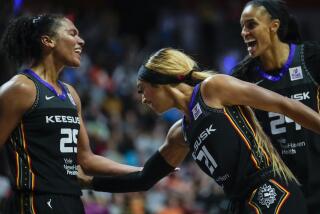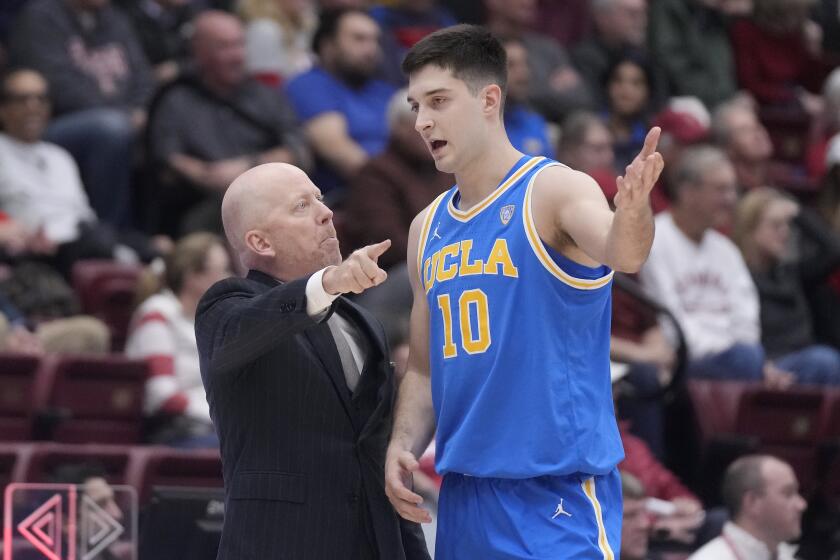COLLEGE FOOTBALL ’92 : Campus Focus, Fiscal Savior : Football Reigns Supreme at SDSU, Where Success Generates Revenue
Shortly after the start of football workouts a couple of weeks ago, former Nevada Las Vegas basketball coach Jerry Tarkanian visited a San Diego State practice.
The juxtaposition was apparent. One of the winningest coaches in college basketball history looked in on a formerly down-and-out football program that thinks it is close to joining the big boys.
It was the first time Tarkanian had been outside of the gymnasium on the SDSU campus, and one thing grabbed his attention.
“I can’t believe the football offices,” Tarkanian gushed. “They’re beautiful.”
Cultures build monuments to their gods.
At SDSU, where the athletic department plods along amid the state’s worst fiscal condition in recent years, football is king.
Fred Miller, SDSU athletic director, does not hide it. He believes the only way for a Division I athletic department to thrive to field a first-class football team.
“Survival,” Miller said. “We reduced four sports and three positions this summer, and that’s a painful process. Our backs are to the financial wall.
“That’s OK. Fear is a great motivator.”
Miller and his associates eliminated men’s track, men’s and women’s golf and wrestling, and they terminated Gary Stathas, former men’s track coach; Rudy Suwara, former women’s volleyball coach; and Dan Underwood, recruiting coordinator for the athletic department.
Under the shadow of jobs lost, an unyielding recession and a state without a budget, the SDSU athletic program dances on a fiscal tightrope.
The pressure mounts for the Aztec football team to provide some solid ground.
“As we move through the early ‘90s to the mid-’90s, as you look across the country, more and more programs are cutting back,” SDSU Coach Al Luginbill said. “And more pressure goes toward football and basketball to succeed.
“But I can’t spend one ounce of energy even thinking in those terms. We have to get ready to play the best football we can.”
With the potential for each victory to translate into thousands of dollars--the more victories, the more bowl and television money--the Aztecs face their most difficult schedule.
Their non-Western Athletic Conference opponents are USC, UCLA, and Miami.
“Yeah,” said Aztec quarterback David Lowery. “I’m around a lot of other people, other athletes, and I’m always aware (of football’s role as the chief moneymaker).
“A couple of guys in my fraternity were on the wrestling team. One of them has transferred.
“It’s sad. We need all of these sports to make a successful university. I just hope we can keep winning so we can bring those other sports back.”
Miller said SDSU already surpassed its season-ticket goal for 1992 of about $925,000, estimating that the school has sold more than $1 million worth of tickets so far.
Aztec football players certainly are aware of their station.
“I’m aware of what’s going on around me,” senior defensive back Robert Griffith said. “I know a couple of guys who ran track, but there is no longer a program. Coaches are getting fired. We read the paper.”
Griffith, an electrical engineering major, also feels the budget crunch in another area: When SDSU canceled its aerospace engineering major, “half the guys I study with had to change majors,” Griffith said.
Miller, though, does not think the players should shoulder the burden.
“If I’m a player, I don’t think you even look at it,” Miller said. “As an administrator, I’m the one who feels the pressure.
“We know if we ring the chimes in football, a lot of things can happen.”
That means the Aztecs will not skimp on football.
* The 32,000-square foot, $3.5-million building Tarkanian complimented is known officially as the “Aztec Athletic Center.” To those on campus, it is the “Football Operations Building.”
* Athletes in other sports watch the football players at the training table from the opening of fall camp through the end of the season. Other sports either have no training table or a limited one.
* Athletes in other sports watch the football players walk around in several several new T-shirts each season, such as this year’s “Mental Toughness/Gotta Have It” and “Be In The Top 25” models.
* When the football team is ready to use its weight room, athletes in other sports are usually forced to stop their workouts even if they are not done.
* While the Olympic sports at SDSU are losing positions and scholarships, ex-football coaches continue to be paid.
Denny Stolz, fired after the 1988 season, remains on the payroll in a fund-raising position. Dave Lay, fired as an assistant after the 1991 season, recently reached a settlement with the school. And Underwood, removed from his position of assistant head football coach after 1991, was on the payroll until taking an early retirement a couple of weeks ago. Still, Aztec coaches refuse to complain publicly. Some, fearful of being the next to lose their jobs in the poor economic climate, keep their mouths shut. Others believe that football gets what is necessary.
“I think they get what they need,” said men’s tennis Coach Hugh Bream, in his fifth season at SDSU. “I don’t think there is a lot of fat in their program. Certainly, they are the one sport that has the potential to put 60,000 people in the seats.
“I’d love to have their budget, but with that and the support of the athletic department and media, we’re not going to draw 60,000.
“There’s a certain amount of envy. These guys get everything they want. But they work hard, and you begin to respect them.”
Athletes in other sports at SDSU are resigned to the fact that, in the near future, they will not have it nearly as good.
“They made all their money,” SDSU basketball player Joe McNaull said in reference to the football operations center, built with donated materials and labor. “They went out and got sponsors. They did what it takes.”
Some athletes are matter-of-fact. Others feel the budget squeeze more acutely.
Tier I sports--high-profile, fully funded at SDSU--have a training table, but the football team’s is the most extensive. Volleyball player Gracie Schutt watches the football team devour three different types of salads, sandwiches and snacks for lunch while her team is provided one type of salad.
“And it looks like it is weeds,” Schutt said.
And there are the mornings when the football team has various muffins, bagels and fruit salads. Schutt said the volleyball team usually gets bran or blueberry muffins.
The team complained once, Schutt said, and asked for poppyseed muffins after seeing them in the hands of the football team.
“So they brought us five,” Schutt said. “For 16 girls.”
She added: “Yes, they are the money-winners, but sometimes I wonder if the money that comes in ever goes to other sports. They need to treat the other sports equally. We’re athletes, too.”
Men’s soccer Coach Chuck Clegg sees the differences. But he understands the need to put emphasis on football and adds that neither he nor the team feels snubbed.
“We aren’t treated as (second-class citizens),” said Clegg, who is entering his 11th season. “Most people in the athletic department make an effort to treat us with respect.
“Athletics is a business. I don’t have a problem with that. It’s always been a business.”
Clegg estimated that 70-80% of his team’s money spent is gathered through their own fund-raisers. The SDSU men’s soccer team offers 2 1/2 scholarships and competes against schools that offer eight or nine.
“I’m in favor of grants-in-aid consisting of tuition only,” Clegg said. “The rest of it should be need-based. This way, the athletic department can survive without impacting the university.
“I feel if we do that, we’ll be back to what college athletics are all about.”
Bream’s men’s tennis team is working under constraints similar to Clegg’s. Like other non-Tier I sports at SDSU, Bream holds his program together with glue and Popsicle sticks. Yet this spring, the Aztec men’s tennis team will play three of the top five teams in the nation--USC, UCLA and Pepperdine.
While preparing, his club also will be watching the football team--knowing that a good season will make things better for the rest of the department.
“It’s undeniable,” Bream said. “For the most part, the students and coaches (in the SDSU athletic department) are looking at it with optimism rather than trepidation. It’s exciting to see things improving (in the football program).”
Said soccer player Tim Foster: “I don’t know if they feel it or not but, I think, as far as the (SDSU) athletes go, people are expecting them to do well to help the whole department. If they do well, it turns out good for everybody.”
Bream characterized morale in the department as low this summer but said coaches now are focused on getting their teams ready for their seasons.
“Most people in the Cal State system tend to be survivors,” Bream said.
And at SDSU, they get used to it. They can only dream of having the freedom the football team has.
“Some things you can’t help,” Miller said. “What is, is.”
He points out the football program netted $1.9 million last season.
“Which keeps us afloat,” Miller said. “We’re not in a reserve situation.”
Even though the Greater San Diego Sports Assn. rather than SDSU is promoting the Sept. 5 season opener against USC, Miller said the Aztecs are expecting to net $225,000.
Because of that, and because the Aztecs will make at least three appearances on national or regional network television--with the possibility of five--Miller finds the pressure on this year’s team acceptable.
“People are aware that the Aztecs have a chance to succeed,” he said. “It’s great playing a school like USC, a national university. . . .
“I think we’ve been aggressive in our scheduling. We think we need to step up in order to win this town back--and we’re stepping up. . . . I’m excited about this football season.”
With a few breaks, the Aztecs could wind up in their second consecutive bowl game--which would be a first for SDSU since the school has been Division I.
But the key is getting the breaks. Yes, the Aztecs earned almost $650,000 from their appearance in the Freedom Bowl last season, but the bean counters in the athletic department will not soon forget the blown four-touchdown lead against Brigham Young on Nov. 16.
Had they won that game, the Aztecs would have clinched a Holiday Bowl berth--and a $1.3 million payout.
Now, they will roll the dice again. A successful season could land the Aztecs in one of three bowls, thanks to an agreement between the Western Athletic Conference and Aloha and Copper Bowls.
If the Aztecs can win the WAC title, the Holiday Bowl payout this year is $1.5 million per team. An appearance in either the Aloha Bowl (about $800,000 per team) or the Copper Bowl (about $650,000 per team) also would produce a bonus.
But a missed pass here, an injury there, and the dollar signs will fade away.
“When you get it going, it’s electric,” Miller said. “That’s the magic part of the dance. I love that part of the dance.”
So do most others in the SDSU athletic department. Because the faster the football team dances, the more comfortable it is for them.
USC, UCLA SEASON PREVIEWS: C4
More to Read
Go beyond the scoreboard
Get the latest on L.A.'s teams in the daily Sports Report newsletter.
You may occasionally receive promotional content from the Los Angeles Times.










